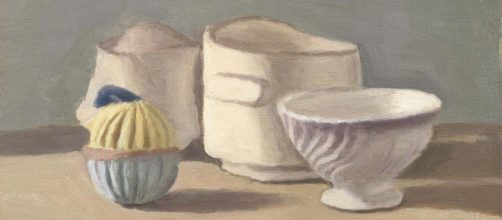Let’s talk about still-life painting. It’s not always about fruit and flowers. When it’s good, it can simply be a state of mind. (More about that in a moment). I rush to say, however, that its affectability can be overstated.
Consider the views of art historian John Thomas Spike. You probably don’t think of sex when you look at Caravaggio’s “Still Life with Fruit on a Stone Ledge,” but Spike sees it everywhere in the painting.
Say what?
The author of the 2010 book “Caravaggio” Spike says: “To our post-Freudian eyes, the serpentine form of the gourd seems explicitly phallic.” “Explicitly”?
The historian also sees female anatomy in this same still life, saying, “The short, stemless figs could readily suggest to anyone thinking along these lines, a thinly disguised representations of the female sex.'' Readily”?
Are you buying any of this? Of course, if you're thinking about sex, probably anything, even a fire hydrant or a cleft in a chin, might seem erotic.
If there's any extra meaning to Caravaggio’s still life, I'd say it was the same one he had when painting "Supper at Emmaus,'' which pictures the resurrected Jesus revealing himself to his disciples. The basket of overripe fruit on the table’s edge might be a reminder that life on earth is fleeting, and that produce withers and rots, as we all will.
And if you’re still looking for coded messages in "Still Life with Fruit on a Stone Ledge,'' the strong shadows could speak of Caravaggio's depression about getting exiled from Rome after killing a man in an argument over a tennis game. Assuming he was depressed, of course.
No tall tales to tell
But Jonathan Jones, art critic for The Guardian, makes a case for still- life painting by Giorgio Morandi – on view at the Estorick Collection, London – that makes the scene without a script.
Morandi was an early 20th-century artist who painted bottles and pots in varying greys and whites so subdued that you feel like whispering on seeing it.
Or else you’re moved to wax poetic as Jones has. He points out that even though still-life painting is an ancient genre seen on the walls of Pompeii villas, Morandi infused it “with a peculiarly modern solitude.” (I wish I’d said that).
And all the time you’re looking at jars, bottles, bowls, and vases, you get that quiet, alone air, that sense of “solitude” that Jones cited.
Another thing you’ll notice. There’s no shininess, no reflection on any of Morandi’s objects. Their complete lack of showiness is what holds you. There’s hardly even a shadow or a highlight. There’s only the muted stillness.
I think the best part of Morandi’s work is that it tells no story. His still-life is simply about itself without reference to anything else to dress it up.
Unlike Paul Cézanne who used the still-life genre only to break it down and build it up to emphasize its solidity. As Jones rightly notes, Morandi doesn’t take perception apart like the Cubists did.
Instead, Morandi seems to brood on what Jones calls “the simultaneous banality and poetry of the shapes of things.” Mind you, what we’re talking about are kitchen objects in a blank space of grayness.
Yet there’s this enigmatic, Delphian aspect that keeps you looking and looking. And you don’t have to cross the pond to see Morandi’s work. The Met has a beaut – a 1951 still-life of ceramic containers that beckon with their near-ethereal shades.
Maybe that’s why Federico Fellini featured Morandi’s still-life paintings in his 1960 movie "La Dolce Vita." What you get is good old-fashioned painting. What a concept!


